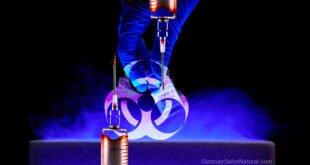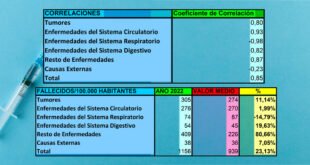Colabore con nosotros para que podamos subtitular este video antes que nos quieran obligar a inyectarnos las vacunas de RNA mensajero nunca antes probadas ni siquiera en animales que causan serios problemas de autoinmunidad
El ensayo clínico conocido como «Infusión de vitamina C para el tratamiento de la neumonía grave infectada por nCoV 2019» fue patrocinado recientemente por el Dr. Peng Zhiyong , director de medicina aguda en el Hospital Central Sur de la Universidad de Wuhan (Hospital Zhongnan).
El Hospital Zhongnan es donde los pacientes infectados por primera vez con el nuevo coronavirus COVID-19 Wuhan fueron tratados. El Dr. Peng está en una posición única para comentar sobre el ácido ascórbico (AA) como un tratamiento efectivo para el coronavirus de Wuhan por su experiencia en cómo se comporta el coronavirus y cómo el AA puede atacar el coronavirus al aumentar la inmunidad.
Lo siguiente son extractos tomados de una entrevista personal al Dr. Peng de lo que ha observado en pacientes infectados por el coronavirus y posteriormente tratados en el Hospital Zhongnan.
La progresión de la enfermedad tarda unas tres semanas, desde el inicio de los síntomas hasta el desarrollo de dificultades para respirar.
1ra semana: desarrollo de síntomas leves a severos que incluyen: debilidad, falta de aliento, fiebre (no todas desarrollan fiebre). Los síntomas más comunes en la primera etapa son fiebre (98.6%), debilidad (69.6%), tos (59.4%), dolores musculares (34.8%), dificultades para respirar (31.2%). Los síntomas menos comunes incluyen dolores de cabeza, mareos, dolor de estómago, diarrea, náuseas, vómitos.
2ª semana: deterioro rápido de los síntomas. En esta etapa debes ir al hospital. Los ancianos o las personas con comorbilidades desarrollarán complicaciones, que requerirán respiración asistida por máquina. Otros con sistemas inmunes funcionales encontrarán una disminución en la severidad de los síntomas en la semana 2 y comenzarán a recuperarse. La segunda semana determina si el paciente puede recuperarse o volverse crítico.
3ª semana: se encontró que los pacientes críticos que recibían tratamiento que podían elevar los recuentos de linfocitos podían evitar la muerte. Otros cuyos recuentos de linfocitos continúan cayendo en picado, lo que indica que la destrucción total del sistema inmune sufre insuficiencia orgánica múltiple y mueren.
Muchos pacientes pudieron recuperarse completamente en dos semanas. El período crítico es la tercera semana, que determina la supervivencia o muerte definitiva del paciente.
¿Qué eleva el recuento de linfocitos en pacientes críticos? Durante una enfermedad crítica, los linfocitos (glóbulos blancos) son los más lentos de restaurar, lo que pone en peligro las posibilidades de recuperación de los pacientes.
La regeneración de un subconjunto de linfocitos conocidos como linfocitos T es especialmente importante en la lucha contra las infecciones virales [1]. El ácido ascórbico (AA) se ha encontrado para mejorar la proliferación de células T humanas in vitro [2].
AA puede promover la maduración de las células T y se ha demostrado que es INDISPENSABLE para el desarrollo de células T in vitro. Sin AA, ocurriría un arresto preT en la etapa celular, inhibiendo el desarrollo y la maduración [3].
AA puede acelerar la regeneración y proliferación de células asesinas naturales (NK) [4].
Las células asesinas naturales (NK) son linfocitos únicos sin un receptor clonalmente específico y las células NK juegan un papel clave en nuestra defensa contra las infecciones virales [5].
Las células NK son críticas para el control de infecciones virales [6].
El ácido ascórbico no solo es capaz de proteger las mitocondrias durante las infecciones virales [7],
Puede fortalecer nuestro sistema inmunológico al proteger y regenerar los linfocitos críticos [8, 9].
Es por eso que el Dr. Peng está llevando a cabo un ensayo clínico a partir del 11 de febrero de 2020 con vitamina C. El ensayo administrará 24 g de C IV a pacientes infectados en condiciones críticas [10].
Todos mis amigos que aumentaron su dosis y frecuencia de AA durante la primera aparición de síntomas de resfriado / gripe me han dicho que experimentaron una resolución rápida y muy efectiva en 48 horas. A partir del 12 de febrero de 2020, la Organización Mundial de la Salud ha cambiado el nombre de 2019-nCoV como COVID-19 [11].
References:
[1] https://www.ncbi.nlm.nih.gov/pubmed/10979980/[2] https://www.ncbi.nlm.nih.gov/pubmed/25157026/[3] https://www.ncbi.nlm.nih.gov/pubmed/25157026/[4] https://www.ncbi.nlm.nih.gov/pubmed/25747742/[5] https://www.ncbi.nlm.nih.gov/pmc/articles/PMC3128146/[6] https://www.ncbi.nlm.nih.gov/pubmed/17466596/[7] https://www.evolutamente.it/mitochondria-the-coronavirus-the-vitamin-c-connection-part-3/[8] https://link.springer.com/article/10.2478/s11536-010-0066-x[9] https://www.ncbi.nlm.nih.gov/pmc/articles/PMC5874527/[10] https://clinicaltrials.govict2/show/NCT04264533[11] https://www.who.int/docs/default-source/coronaviruse/situation-reports/20200211-sitrep-22-ncov.pdfNo se puede subestimar la importancia de un suministro continuo de ácido ascórbico adecuado durante las tormentas de citoquinas inducidas por infecciones por coronavirus.
Más Referencias:
- Short KR, Kroeze EJ, Fouchier RA, Kuiken T. Pathogenesis of influenza-induced acute respiratory distress syndrome. Lancet Infect Dis. 2014;14:57–69. [PubMed] [Google Scholar]
2. Zaki AM, van Boheemen S, Bestebroer TM, Osterhaus AD, Fouchier RA. Isolation of a novel coronavirus from a man with pneumonia in Saudi Arabia. N Engl J Med. 2012;367:1814–1820. [PubMed] [Google Scholar]
5. de Jong MD, Simmons CP, Thanh TT, Hien VM, Smith GJ, Chau TN, Hoang DM, Chau NV, Khanh TH, Dong VC, et al. Fatal outcome of human influenza A (H5N1) is associated with high viral load and hypercytokinemia. Nat Med. 2006;12:1203–1207. [PMC free article] [PubMed] [Google Scholar]
15. Nathens AB, Neff MJ, Jurkovich GJ, Klotz P, Farver K, Ruzinski JT, Radella F, Garcia I, Maier RV. Randomized, prospective trial of antioxidant supplementation in critically ill surgical patients. Ann Surg. 2002;236:814–822. [PMC free article] [PubMed] [Google Scholar]
16. Tanaka H, Matsuda T, Miyagantani Y, Yukioka T, Matsuda H, Shimazaki S. Reduction of resuscitation fluid volumes in severely burned patients using ascorbic acid administration: a randomized, prospective study. Arch Surg. 2000;135:326–331. [PubMed] [Google Scholar]
17. Sawyer MAJ, Mike JJ, Chavin K. Antioxidant therapy and survival in ARDS (abstract) Crit Care Med. 1989;17:S153. [Google Scholar]
18. Fowler AA, Syed AA, Knowlson S, Sculthorpe R, Farthing D, DeWilde C, Farthing CA, Larus TL, Martin E, Brophy DF, et al. Phase I safety trial of intravenous ascorbic acid in patients with severe sepsis. J Transl Med. 2014;12:32. [PMC free article] [PubMed] [Google Scholar]
19. Fisher BJ, Seropian IM, Kraskauskas D, Thakkar JN, Voelkel NF, Fowler AA, Natarajan R. Ascorbic acid attenuates lipopolysaccharide-induced acute lung injury. Crit Care Med. 2011;39:1454–1460. [PubMed] [Google Scholar]
20. Fisher BJ, Kraskauskas D, Martin EJ, Farkas D, Puri P, Massey HD, Idowu MO, Brophy DF, Voelkel NF, Fowler AA, et al. Attenuation of sepsis-induced organ injury in mice by vitamin C. JPEN J Parenter Enteral Nutr. 2014;38:825–839. [PubMed] [Google Scholar]
21. Fisher BJ, Kraskauskas D, Martin EJ, Farkas D, Wegelin JA, Brophy D, Ward KR, Voelkel NF, Fowler AA, Natarajan R. Mechanisms of attenuation of abdominal sepsis induced acute lung injury by ascorbic acid. Am J Physiol Lung Cell Mol Physiol. 2012;303:L20–L32. [PubMed] [Google Scholar]
22. Berger MM, Oudemans-van Straaten HM. Vitamin C supplementation in the critically ill patient. Curr Opin Clin Nutr Metab Care. 2015;18:193–201. [PubMed] [Google Scholar][42] Mitochondria as central hub of the immune system – ScienceDirect https://www.sciencedirect.com/science/article/pii/S2213231719303076
[43] Mitochondria are the powerhouses of immunity | Nature Immunology https://www.nature.com/articles/ni.3704?draft=marketing[44] Diverse Roles of Mitochondria in Immune Responses: Novel Insights Into Immuno-Metabolism | Immunology https://www.frontiersin.org/articles/10.3389/fimmu.2018.01605/full[45] Mitochondrial dynamics and viral infections: A close nexus – ScienceDirect https://www.sciencedirect.com/science/article/pii/S0167488915000099 [46] The essential role of mitochondrial dynamics in antiviral immunity https://www.ncbi.nlm.nih.gov/pmc/articles/PMC5988924/ [47] Outer mitochondrial membrane permeabilization during apoptosis triggers caspase-independent mitochondrial and caspase-dependent plasma membrane potential depolarization: a single-cell analysis | Journal of Cell Science https://jcs.biologists.org/content/116/3/525[48] Coupling of Phosphorylation to Electron and Hydrogen Transfer by a Chemi-Osmotic type of Mechanism | Nature https://www.nature.com/articles/191144a0[49] Cristae – The Powerhouses Within – EvolutaMente.it https://www.evolutamente.it/cristae-the-powerhouses-within/ [50] Individual cristae within the same mitochondrion display different membrane potentials and are functionally independent | The EMBO Journal https://www.embopress.org/doi/full/10.15252/embj.2018101056[51] Fission and selective fusion govern mitochondrial segregation and elimination by autophagy https://www.ncbi.nlm.nih.gov/pmc/articles/PMC2234339/ [52] Fission and selective fusion govern mitochondrial segregation and elimination by autophagy. – PubMed – NCBI https://www.ncbi.nlm.nih.gov/pubmed/18200046/[53] Role of mitochondrial membrane permeabilization and depolarization in platelet apoptosis – Leytin – 2018 – British Journal of Haematology – Wiley Online Library https://onlinelibrary.wiley.com/doi/full/10.1111/bjh.14903[54] Exploring the Effect of Rotenone—A Known Inducer of Parkinson’s Disease—On Mitochondrial Dynamics in Dictyostelium discoideum https://www.ncbi.nlm.nih.gov/pmc/articles/PMC6262481/[55] Vitamin C enters mitochondria via facilitative glucose transporter 1 (Glut1) and confers mitochondrial protection against oxidative injury | The FASEB Journal https://www.fasebj.org/doi/full/10.1096/fj.05-4107com?ck=nck&legid=fasebj%3B19%2F12%2F1657&cited-by=yes[56] Vitamin C Antagonizes the Cytotoxic Effects of Antineoplastic Drugs | Cancer Research https://cancerres.aacrjournals.org/content/68/19/8031 [57] Ionizing radiation-induced, mitochondria-dependent generation of reactive oxygen/nitrogen. – PubMed – NCBI https://www.ncbi.nlm.nih.gov/pubmed/11358802[58] Ascorbic acid inhibits apoptosis induced by X irradiation in HL60 myeloid leukemia cells. – PubMed – NCBI https://www.ncbi.nlm.nih.gov/pubmed/10521923?dopt=Abstract[59] SARS-CoV Nucleocapsid Protein Induced Apoptosis of COS-1 Mediated by the Mitochondrial Pathway: Artificial Cells, Blood Substitutes, and Biotechnology: Vol 35, No 2 https://www.tandfonline.com/doi/full/10.1080/10731190601188422#[60] The Influence of Micronutrients in Cell Culture: A Reflection on Viability and Genomic Stability https://www.hindawi.com/journals/bmri/2013/597282/[61] Chiral analysis of ascorbic acid in bovine serum using ultrathin molecular imprinted polyaniline/graphite electrode – ScienceDirect https://www.sciencedirect.com/science/article/pii/S1572665717302953[62] Thioredoxin Reductase AFR NADH NADPH_Molecular biology of mammalian AFR reductases https://www.researchgate.net/publication/236015879_Molecular_biology_of_mammalian_AFR_reductases[63] Characterization of the Trans-plasma Membrane Electron Transport System in the Myelin Membrane https://scholars.wlu.ca/cgi/viewcontent.cgi?referer=https://www.google.com/&httpsredir=1&article=2785&context=etd[64] External mitochondrial NADH-dependent reductase of redox cyclers: VDAC1 or Cyb5R3? – ScienceDirect https://www.sciencedirect.com/science/article/abs/pii/S0891584914002573?via%3Dihub[65] Paraquat toxicity induced by voltage-dependent anion channel 1 acts as an NADH-dependent oxidoreductase. – PubMed – NCBI https://www.ncbi.nlm.nih.gov/pubmed/19717555[66] Paraquat induces oxidative stress and neuronal cell death; neuroprotection by water-soluble Coenzyme Q10. – PubMed – NCBI https://www.ncbi.nlm.nih.gov/pubmed/15519605[67]Cytochrome B5 Reductase 3 Is Essential for Cardiomyocyte Function | Circulation https://www.ahajournals.org/doi/abs/10.1161/circ.136.suppl_1.20733[68] Vitamin C versus Cancer: Ascorbic Acid Radical and Impairment of Mitochondrial Respiration? https://new.hindawi.com/journals/omcl/2020/1504048/[69] Modulation of Cytochrome c-Mediated Extramitochondrial NADH Oxidation by Contact Site Density – ScienceDirect https://www.sciencedirect.com/science/article/abs/pii/S0006291X99907878[70] Membrane potential generation coupled to oxidation of external NADH in liver mitochondria. – PubMed – NCBI https://www.ncbi.nlm.nih.gov/pubmed/9762923[71] Cytochrome c-induced cytosolic nicotinamide adenine dinucleotide oxidation, mitochondrial permeability transition, and apoptosis. – PubMed – NCBI https://www.ncbi.nlm.nih.gov/pubmed/12573279 [72] Porin and cytochrome oxidase containing contact sites involved in the oxidation of cytosolic NADH. – PubMed – NCBI https://www.ncbi.nlm.nih.gov/pubmed/15752713



